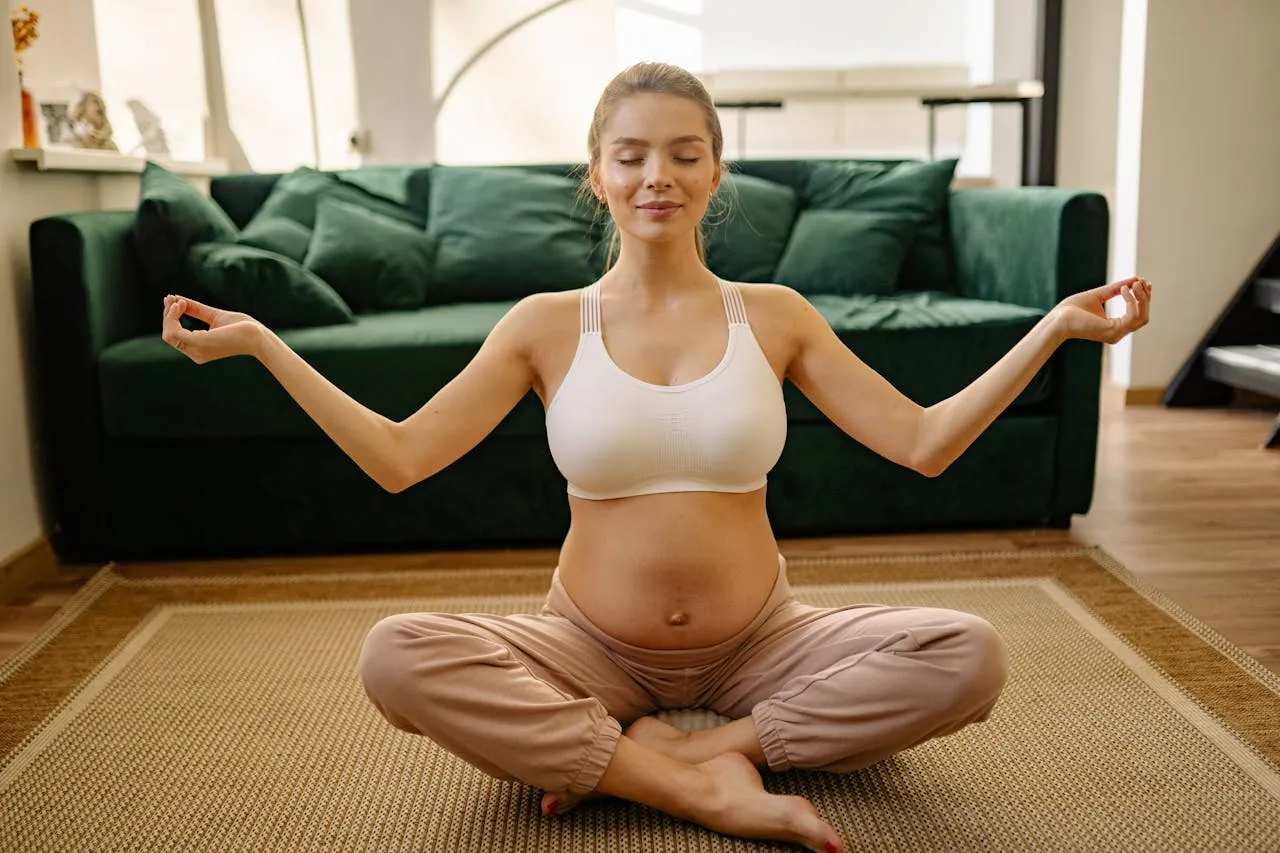
Introduction
Prenatal yoga at home is one of the easiest, safest ways to keep your body active and your mind relaxed during pregnancy. You don’t need fancy equipment, a big space, or even much experience—just a mat, a calm spot, and a few minutes a day.
Table of Contents
- Why Home Yoga Works Wonders During Pregnancy?
- Things You’ll Need Before You Start
- Is Prenatal Yoga Safe for All Trimesters?
- 1st Trimester Yoga Poses (Gentle and Grounding)
- 2nd Trimester Yoga Poses (Balance, Breath, and Posture)
- 3rd Trimester Yoga Poses (Supportive, Calm Stretches)
- 5-Minute Quick Yoga Flow for Tired Days
- Yoga Exercises for Constipation, Gas, and Fatigue
- Face and Posture Yoga for Moms
- What to Avoid in Prenatal Yoga
- Conclusion: Move Safely, Feel Stronger, Stay Calm
- References and Further Reading
- Frequently Asked Questions
Why Home Yoga Works Wonders During Pregnancy?
During pregnancy, your body changes fast—and not always in ways you expect. Muscles ache. Sleep feels tricky. Some days you’re full of energy, others not so much. That’s where gentle, guided prenatal yoga steps in. It’s flexible (literally), low-impact, and tailored to your trimester. Whether you’re in your first month or your last, yoga can offer comfort, strength, and inner peace.
Things You’ll Need Before You Start
You don’t need much to begin prenatal yoga at home—just a few basics to keep you safe and comfortable. A good mat, stable props, and loose clothing go a long way.
Here’s a quick checklist:
- Yoga mat with grip to prevent slipping
- Yoga ball or bolster for support
- Yoga chair for seated poses or balance
- Pillow or cushion for knees and back
- Water bottle to stay hydrated
- Loose, breathable clothing
Is Prenatal Yoga Safe for All Trimesters?
Yes, prenatal yoga is generally safe for all trimesters, as long as it’s adapted to your stage of pregnancy and approved by your doctor. The key is listening to your body and avoiding poses that put pressure on your belly or strain your back.
In the first trimester, focus on gentle breathing and light stretching. The second trimester allows for deeper movements—just use props like a yoga chair or ball for balance.
By the third trimester, slow, supported poses help ease discomfort and prepare your body for labour. If anything feels off, skip it. Comfort always comes first.
1st Trimester Yoga Poses (Gentle and Grounding)
During the first trimester, the focus should be on calming the nervous system, improving circulation, and easing nausea or fatigue. Keep movements light and supportive.
Here are 2 safe, beginner-friendly poses
- Bound Angle Pose (Butterfly) – Opens the hips and improves blood flow.
- Seated Side Stretch – Relieves tension in the sides and helps with deep breathing.
- These are simple, but effective. Keep breathing steadily and avoid holding poses for too long. If you feel dizzy or tired, pause.
2nd Trimester Yoga Poses (Balance, Breath, and Posture)
In the second trimester, your belly starts to show, and balance may feel tricky. Focus on poses that support your posture, strengthen your legs, and open your chest for better breathing.
Here are 3 great options:
- Warrior II – Builds strength and stability in legs and hips.
- Triangle Pose (with a block) – Stretches your sides and helps digestion.
- Wide-Knee Child’s Pose – Offers rest and releases back tension.
Use a yoga chair or wall support if your balance feels off. These poses also encourage better posture as your body changes.
3rd Trimester Yoga Poses (Supportive, Calm Stretches)
By the third trimester, your yoga routine should slow down. Choose poses that reduce pressure, improve circulation, and create space for your baby to move comfortably.
Try these gentle poses:
- Supported Squat (using a yoga ball or wall) – Helps prepare hips for delivery.
- Butterfly Pose with Cushion – Relieves tight hips and pelvic pressure.
- Side-Lying Savasana – The safest way to rest and reset.
Avoid lying flat on your back. Use pillows, blocks, or a yoga chair for support. This is the time to focus on calm breathing and body awareness.
5-Minute Quick Yoga Flow for Tired Days
Don’t feel up for a full session? Just five minutes of gentle movement can ease your body and calm your mind. This short routine is perfect for those sluggish, low-energy days.
Here’s a simple 5-minute prenatal yoga flow
- Seated Neck Rolls (30 sec) – Loosens upper tension
- Cat-Cow Stretch (1 min) – Relieves back pain
- Child’s Pose (1 min) – Encourages deep breathing
- Butterfly Pose (1 min) – Opens hips gently
- Side-Lying Rest (1.5 min) – Wind down and reset
Yoga Exercises for Constipation, Gas, and Fatigue
These gentle poses support digestion, ease bloating, and improve circulation—three things every pregnant mom needs help with.
Wind-Relieving Pose (on side) – Eases trapped gas without compressing your belly
Seated Twist (gentle, open twist) – Stimulates digestion
Legs Up the Wall (with pillow) – Helps with fatigue, circulation, and bloating
If lying on your back feels uncomfortable, modify with cushions. These are best after meals or at night before bed.
Face and Posture Yoga for Moms
Face and posture yoga may sound small, but they can help you feel more energised, reduce puffiness, and relieve upper-body strain.
Face Yoga: Puff Cheek Hold & Jaw Release – Reduces facial tension and promotes circulation
Wall Posture Pose – Stand with your back against a wall for 2 minutes to realign your spine
Shoulder Rolls + Chin Tucks – Counteracts forward head posture from phone use and breastfeeding prep
What to Avoid in Prenatal Yoga
Not all yoga poses are safe during pregnancy. Avoid anything that compresses your belly, strains your lower back, or makes you feel dizzy or breathless.
Skip these
- Deep twists – Can restrict blood flow to your baby
- Backbends or belly-down poses (like Cobra)
- Lying flat on your back after 20 weeks – May reduce blood flow
- Hot yoga – Overheating is risky in pregnancy
- Advanced balance poses without support
Note: Always talk to your doctor before starting a new pose or routine—especially if you have back pain, spotting, or a high-risk pregnancy.
Conclusion: Move Safely, Feel Stronger, Stay Calm

Prenatal yoga at home isn’t about doing more—it’s about feeling better, day by day. Whether you’re stretching for five minutes or flowing for forty, each pose supports your changing body and growing baby.
Start with what feels right. Use a chair, a wall, or just your breath. And when in doubt, check in with your doctor.
At Healthtolife, we’re here to guide you with calm, clear tips that real moms trust. Bookmark this guide, share it with a friend, or return when your body says, “I need a little care today.”
References and Further Reading
This article is based on solid research and authentic medical information using reliable global sources such as the World Health Organisation (WHO) and Healthline.
We invite you to explore our article library for more in-depth guidance on health-related topics, disease symptoms, nutrition, and wellness.
View all health-related articles here: https://healthtolife.in/category/women-s-wellness/
At Healthtolife, our goal is to provide you with safe, research-based, and easy-to-understand information so you can live a healthier life.
Your health is our priority. That’s why our team of experts is always reviewing the latest studies and updating our content to bring you the best advice. If you found this article helpful, we’d truly value your feedback—feel free to share your thoughts in the comments below. Thank you for spending your time with HealthToLife.
Frequently Asked Questions
Ques-1: What yoga poses should I avoid while pregnant?
Ans: Avoid deep twists, backbends, belly-down poses, and hot yoga during pregnancy. Also, skip anything that feels uncomfortable, dizzying, or puts pressure on your belly. Always check with your doctor before starting a new yoga routine.
Ques-2: What’s the best prenatal yoga for beginners at home?
Ans: The best prenatal yoga for beginners at home includes Cat-Cow, Butterfly Pose, and Seated Side Bends. These are safe, gentle, and easy to follow in your first trimester. Use a mat, cushion, or chair to support your body.
Ques-3: Can I do prenatal yoga in all trimesters?
Ans: Yes, prenatal yoga is safe for all trimesters if modified for each stage and approved by your doctor. Avoid lying on your back after 20 weeks, and choose poses that support your hips, back, and balance as your body changes.
Ques-4: Are chair yoga exercises helpful during pregnancy?
Ans: Yes, prenatal chair yoga is ideal when energy is low or movement is limited. It offers support while reducing strain. Seated Cat-Cow, gentle side bends, and forward folds can help relieve back pain and fatigue.
Ques-5: How often should I do prenatal yoga?
Ans: 2 to 4 times per week is enough for most pregnant women. Listen to your body, start slow, and focus on consistency, not intensity. Even 10-minute sessions can improve posture, sleep, and mood.
Related Video | Pregnancy Guide: Asanas, Nutrition, Skincare, Mood Swings & Baby Care | Motherhood | Dr. Hansa Yogendra
Was this article helpful?
Stay updated with the latest posts on HealthToLife—expert health tips, wellness trends, and life-changing advice you don’t want to miss. Click to explore.



